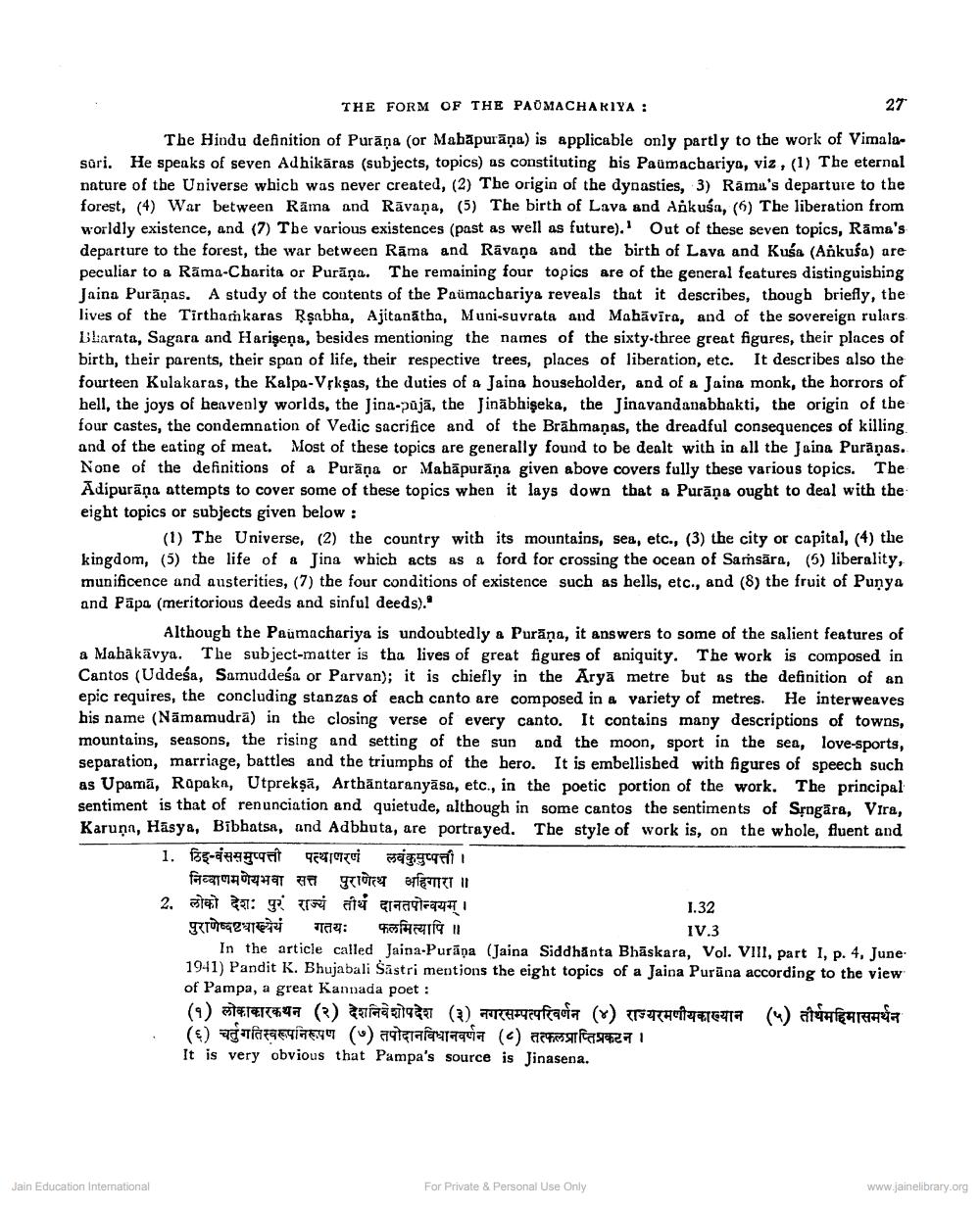________________
THE FORM OF THE PAOMACHARIYA :
27
The Hindu definition of Purāņa (or Mabapurāņa) is applicable only partly to the work of Vimalasari. He speaks of seven Adhikāras (subjects, topics) as constituting his Paümacbariya, viz, (1) The eternal nature of the Universe which was never created, (2) The origin of the dynasties, 3) Ramu's departure to the forest, (4) War between Rāma and Rāvana, (5) The birth of Lava and Ankusa, (6) The liberation from worldly existence, and (7) The various existences (past as well as future).' Out of these seven topics, Rāma's departure to the forest, the war between Rāma and Rāvana and the birth of Lava and Kuša (Ankuša) are peculiar to a Rāma-Charita or Purāņa. The remaining four topics are of the general features distinguishing Jaina Purāņas. A study of the contents of the Paümachariya reveals that it describes, though briefly, the lives of the Tirthamkaras Rşabha, Ajitanātha, Muni-suvrata and Mahāvīra, and of the sovereign rulars Dlarnta, Sagara and Harişeņa, besides mentioning the names of the sixty-three great figures, their places of birth, their parents, their span of life, their respective trees, places of liberation, etc. It describes also the fourteen Kulakaras, the Kalpa-Vrkşas, the duties of a Jaina householder, and of a Jaina monk, the horrors of hell, the joys of heavenly worlds, the Jina-pājā, the Jinābhiseka, the Jinavandanabhakti, the origin of the four castes, the condemnation of Vedic sacrifice and of the Brāhmaṇas, the dreadful consequences of killing and of the eating of meat. Most of these topics are generally found to be dealt with in all the Jaina Purāņas. None of the definitions of a Purāņa or Mahāpurāņa given above covers fully these various topics. The Adipurāņa attempts to cover some of these topics when it lays down that a Purāņa ought to deal with the eight topics or subjects given below :
(1) The Universe, (2) the country with its mountains, sea, etc., (3) the city or capital, (4) the kingdom, (5) the life of a Jina which acts as a ford for crossing the ocean of Samsāra, (5) liberality, munificence und austerities, (7) the four conditions of existence such as hells, etc., and (8) the fruit of Punya and Papa (meritorious deeds and sinful deeds)."
Although the Paumachariya is undoubtedly a Purāņa, it answers to some of the salient features of a Mahakavya. The subject matter is tha lives of great figures of aniquity. The work is composed in Cantos (Uddeśa, Samuddeśa or Parvan); it is chiefly in the Aryā metre but as the definition of an epic requires, the concluding stanzas of each canto are composed in a variety of metres. He interweaves his name (Nāmamudra) in the closing verse of every canto. It contains many descriptions of towns, mountains, seasons, the rising and setting of the sun and the moon, sport in the sea, love-sports, separation, marriage, battles and the triumphs of the hero. It is embellished with figures of speech such as Upamā, Ropaka, Utprekşā, Arthăntaranyāsa, etc., in the poetic portion of the work. The principal sentiment is that of renunciation and quietude, although in some cantos the sentiments of Srngāra, Vira, Karuna, Hasya, Bibhatsa, and Adbhuta, are portrayed. The style of work is, on the whole, fluent and
1. f85-1 groeit 990170 saggezeti
निव्याणमणेयभवा सत्त पुराणेत्थ अहिगारा ॥ 2. g rej ata nagla41
1.32 पुराणेष्वरधाख्येयं गतयः फलमित्यापि ॥
IV.3 In the article called Jaina-Purāņa (Jaina Siddhanta Bhāskara, Vol. VIII, part I, p. 4, June 1941) Pandit K. Bhujabali Sastri mentions the eight topics of a Jaina Purana according to the view of Pampa, a great Kannada poet: (१) लोकाकारकथन (२) देशनिवेशोपदेश (३) नगरसम्पत्परिवर्णन (४) राज्यरमणीयकाख्यान (५) तीर्थमहिमासमर्थन (६) चर्तुगतिस्वरूपनिरूपण (५) तपोदानविधानवर्णन (८) तत्फलप्राप्तिप्रकटन । It is very obvious that Pampa's source is Jinasena.
Jain Education International
For Private & Personal Use Only
www.jainelibrary.org




